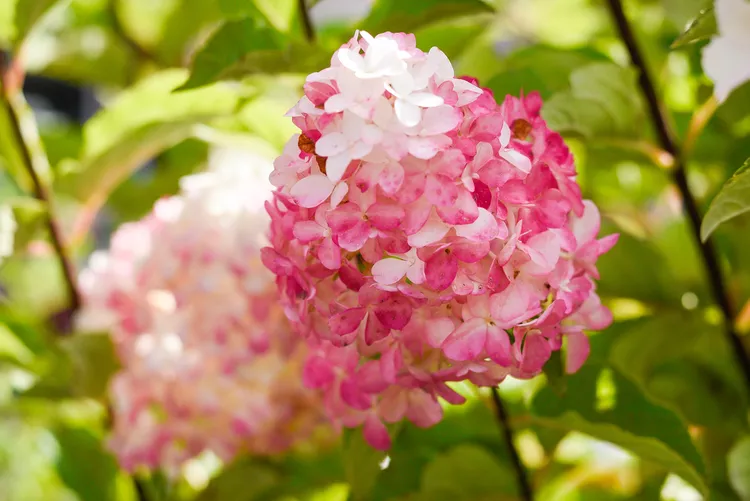Vanilla Strawberry hydrangea (Hydrangea paniculata 'Renhy') was introduced in 2009. Around midsummer, buds open into densely clustered white flowers with pinkish centers. The flower heads take on a deeper and richer blush as they age. The huge, cone-shape blooms form continuously all summer long, giving this shrub a multi-colored effect with bright-white new blooms complementing reddish-pink ones. The unique rosy coloring lasts several weeks and features showy red stems.
Hardy in Zones 3-9, this shrub is easy to care for and will grow in most areas of the country.
Some types of hydrangeas are toxic to humans and pets if ingested.
Where to Plant Vanilla Strawberry Hydrangea
Vanilla Strawberry does best in full sun. Its mature height is 6 to 7 feet with a spread of 4 to 5 feet, so make sure to plant it where it will have room to reach its full size. Because of its size, Vanilla Strawberry hydrangea is a great back-of-the-border or foundation shrub. It also makes a fantastic flowering hedge plant.
The soil should be rich in organic matter, moist, well-drained, and slightly acidic (pH between 6.0 and 6.5).
How and When to Plant Vanilla Strawberry Hydrangea
The best time to plant Vanilla Strawberry is in spring before rapid growth sets in and in late autumn, just as this panicle hydrangea is dormant. Dig a hole that's deep enough and wide enough for the root ball to sit comfortably in. Ensure the stem is at the same soil depth as it was in its container. Mulch around the base to retain soil moisture and suppress weeds.
Space the hydrangeas 4 feet apart for a dense, continuous hedge. Specimen plants that you want to stand out should be planted at least 5 feet apart.
Depending on the size you're starting with, expect your plant to bloom a year or two after planting.
Vanilla Strawberry Hydrangea Care Tips
Care for Vanilla Strawberry hydrangea like you would other panicle hydrangeas.
Light
Vanilla Strawberry hydrangea prefers sunlight, but can grow in partial shade as well.
Soil and Water
Vanilla Strawberry hydrangea isn't picky regarding soil as long as it doesn't get too wet, which can lead to root rot. Choose a spot with rich, well-drained soil, or add compost if the soil is poor.
Once planted, keep your Vanilla Strawberry hydrangea well-watered during its first year to help it get established. These plants are more tolerant of dry conditions than other types of hydrangeas, but keep them watered after the first year to promote blooming, especially when there isn't much rain.
Temperature and Humidity
Vanilla Strawberry hydrangea appreciates afternoon shade in warmer climates in the southern and western regions of the country.
Fertilizer
Vanilla Strawberry hydrangeas grow best when fertilized every so often with organic mulch.
Pruning
This type of hydrangea blooms on new growth instead of the previous season's stems, as some other hydrangea varieties do. That means you don't need to worry about cutting off the next season's blooms when you trim your plant or when a late spring frost zaps all the flowers for the season. Plus, the blooms that remain at season's end provide wintertime interest; they'll dry and turn a parchment color.
To remove the old flowers to make way for new ones, and to encourage new growth, the best time to prune this hydrangea is after the worst of winter's cold has passed—most likely in February or March. You can trim it back by as much as a third every year.
Potting and Repotting Vanilla Strawberry Hydrangea
While Vanilla Strawberry hydrangea might fit in a large container for the first two years when it is still fairly small, it will eventually get too tall and wide for container growing. It should be planted in the landscape from the onset. For potting, dwarf hydrangeas such as Little Quick Fire are a much better choice.
Pests and Problems
Pests and diseases are not typically a problem. And deer don't prefer hydrangeas, but to play it safe, apply a repellent if you live where deer like to visit.
Propagating Strawberry Vanilla Hydrangea
Propagation of Strawberry Vanilla hydrangea is illegal, because it's a patented plant. Since it's trademarked and copyrighted, the only way to add this to a garden is to buy the plant from a nursery. The seeds of Strawberry Vanilla hydrangea are sterile and won't grow if planted.




















